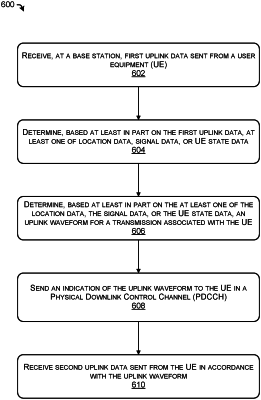| CPC H04W 72/53 (2023.01) [G06N 20/00 (2019.01); H04L 27/2607 (2013.01); H04L 27/2636 (2013.01); H04W 52/241 (2013.01); H04W 52/242 (2013.01); H04W 52/365 (2013.01); H04W 64/00 (2013.01); H04W 72/0453 (2013.01); H04W 72/21 (2023.01); H04W 76/27 (2018.02)] | 16 Claims |

|
1. A method comprising:
receiving, at a base station, first uplink data sent from a user equipment (UE);
determining, based at least in part on the first uplink data, location data, signal data, and UE state data;
inputting the location data, the signal data, and the UE state data to a machine learned model, wherein the machine learned model associates a first uplink waveform with data meeting at least one of a plurality of thresholds and a second uplink waveform with data that does not meet at least one of the plurality of the thresholds, and the first uplink waveform is one of a Discrete Fourier Transform Spread Orthogonal Frequency Division Multiplexing (DFT-s-OFDM) waveform and a Cyclic Prefix OFDM (CP-OFDM) waveform and the second uplink waveform is the other of DFT-s-OFDM and CP-OFDM;
receiving, from the machine learned model, an uplink waveform for a transmission associated with the UE, wherein the uplink waveform is one of the first uplink waveform and the second uplink waveform and is determined by the machine learned model by a comparison of the location data, the signal data, and the UE state data to the plurality of thresholds;
sending an indication of the uplink waveform to the UE in a Physical Downlink Control Channel (PDCCH); and
receiving second uplink data sent from the UE in accordance with the uplink waveform.
|